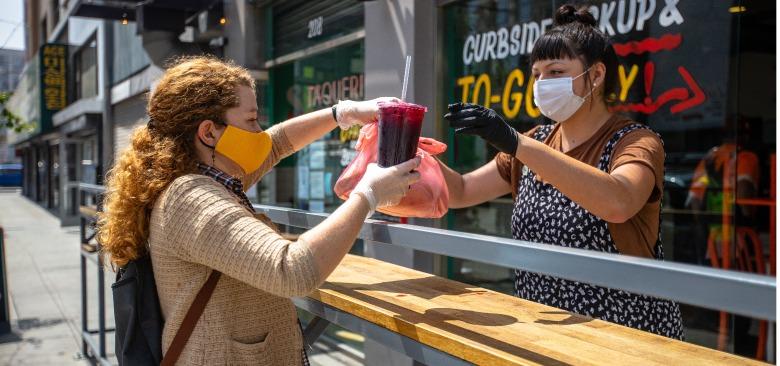
Understanding How Social and Economic Conditions Impact Our Health
From understanding worker well-being to studying barriers to HIV prevention, UCSF School of Nursing community members are leading projects that enhance our understanding of social determinants of health. Here are just some of the projects addressing health equity and informing policy.
Understanding Worker Well-Being
The majority of service sector workers in the United States have unstable schedules. Their work hours change frequently, often on short notice, creating personal and financial stress.
Professor Kristen Harknett, PhD, co-leads The SHIFT Project, the country’s largest data source on service sector workers that was created, in part, to understand more nuanced dimensions of job quality.
Prior to The SHIFT Project, insights on work conditions were limited to annual income or hourly wage data. The SHIFT Project uses survey data from more than 100,000 Kristen Harknett, PhD retail and fast food workers nationwide to draw connections between work conditions and worker well-being. Their dataset is the first of its kind to include employer information.
Kristen Harknett, PhD retail and fast food workers nationwide to draw connections between work conditions and worker well-being. Their dataset is the first of its kind to include employer information.
“Part of the rationale for having employers named is that we’re poised to understand and respond to how specific employer practices impact the well-being of their employees,” says Harknett.
In 2020, when the restaurant chain Olive Garden began offering paid sick leave in response to public criticism, The SHIFT Project was ready.
Their dataset already included Olive Garden employees, so Harknett and her team re-surveyed those respondents to measure the new policy’s impact. They found a 15% decline in workers coming to work sick, an outcome benefitting both worker well-being and public health.
The Shift Project’s robust dataset allows them to inform real-time policy debates. They provide their findings and recommendations to state and city leaders nationwide. Their research was cited in a federal bill on work scheduling that is currently under Senate review.
“Work is an important social determinant of health for everyone, but particularly for service sector workers who face unique vulnerabilities,” Harknett said.
Social Adversity During Pregnancy
Research suggests that stress during pregnancy may change infant physiology, and influence physical, emotional and behavioral health.
But little is known about how stress from prenatal experiences of social adversity – factors like violence, racism, food insecurity – impacts child health outcomes.
 “We need to understand how stress from social adversity changes the body and increases the risk for health conditions,” says Victoria Keeton, PhD, PNP, a postdoctoral scholar with the California Preterm Birth Initiative at UCSF.
“We need to understand how stress from social adversity changes the body and increases the risk for health conditions,” says Victoria Keeton, PhD, PNP, a postdoctoral scholar with the California Preterm Birth Initiative at UCSF.
Utilizing data from a study led by School of Nursing professor Sandra Weiss, PhD, RN, FAAN, Keeton is studying 235 diverse birthing persons and their babies. She is examining the relationship between the birthing person’s social adversity and stress hormones during pregnancy, and their baby’s mood and stress hormones over the first year of life.
Participants reported their experience with up to 60 stressors during their pregnancy. Cortisol, the stress hormone, was analyzed via saliva collected from the birthing person in their third trimester and 6 and 12 months after birth, and from their child at 1, 6 and 12 months of age.
She hopes her findings will inform interventions. “I want to identify optimal times during pregnancy or infancy to address stress regulation so we can prevent or mitigate its potential pathologic consequences.”
Barriers to HIV Prevention and Treatment
Professor Glenn-Milo Santos, PhD, MPH, is working to address structural and social factors that prevent patients from accessing HIV prevention and treatment services.
Santos collaborates with MPact Global Action for Gay Men’s Health and Rights to conduct a survey, now in its fourth cycle, on the experiences of 6,188 sexual and gender minority men globally.
“Individuals who have experienced homophobia, health care provider discrimination due to their sexual orientation or who do not have community support, report lower access to HIV prevention tools,” says Santos. Similar results are reported for accessing HIV treatment.  Glenn-Milo Santos, PhD, MPH
Glenn-Milo Santos, PhD, MPH
This is particularly concerning for individuals living in areas where same-sex intimacy is criminalized.
“We have tools for HIV detection and treatment so that individuals living with HIV can live the same lifespan as those who are not living with HIV, but social and structural factors limit access to life-saving care,” says Santos.
During the coronavirus pandemic, Santos and colleagues explored COVID-19’s impact on HIV prevention and care services for 13,562 gender and sexual minority men globally. They integrated data from the MPact survey, collected before the pandemic, with data from their COVID-19 study.
“COVID-19 reinforced existing barriers to accessing HIV prevention and care and amplified the inequities we had observed prior to the pandemic,” says Santos.
This study provides more evidence that pandemics disproportionally impact populations that already face unique barriers, explains Santos, but it also highlights the important role of health care providers.
“We consistently found that comfort with one’s health care provider translates to better health outcomes,” says Santos. “It’s a call to action for all of us who interact with participants and patients.”
Chronic Stress and Metabolic Syndrome
In the U.S., Mexican American women ages 30-49 are more likely than their non-Hispanic, white counterparts to have metabolic syndrome, a cluster of conditions that increases the risk of heart disease, stroke and type 2 diabetes.
 Edna Esquer, PhD, FNP-BC Edna Esquer, PhD, FNP-BC, a School of Nursing postdoctoral scholar in the National Clinician Scholars Program, explores how social determinants of health contribute to this discrepancy.
Edna Esquer, PhD, FNP-BC Edna Esquer, PhD, FNP-BC, a School of Nursing postdoctoral scholar in the National Clinician Scholars Program, explores how social determinants of health contribute to this discrepancy.
As a nurse scientist and family nurse practitioner in Imperial County, a rural area of California that is 90% Hispanic, Esquer saw first-hand the unique impacts of social determinants of health.
“Environmental pollution, an insufficient number of health care providers and chronic stress are just some of the factors impacting Imperial County residents,” she says.
Esquer studied the association between metabolic syndrome and chronic stress, social support and health behaviors in a cohort of 150 Hispanic women in Imperial County, finding that chronic stress was higher for participants with metabolic syndrome than those without. Limited access to healthy food, unhealthy eating habits and lack of physical activity were social determinants associated with metabolic syndrome.
“There is a lack of research done in non-white, rural populations, which means the information we rely on to direct care is missing the full picture,” says Esquer. To improve health outcomes for Latinos, she is working with community partners to engage more Latinos in clinical research.
Cognitive Behavioral Interventions for Minority Stress
Associate professor Annesa Flentje, PhD, designed an intervention to help reduce stressors related to intersectional stigma and discrimination for sexual and gender minority people.
The cognitive behavioral intervention is a series of nine to 10 individual sessions with a therapist. Each session focuses on an element of these stressors – discrimination experiences, anticipation of discrimination, concealment of identity and internalized stigma.
Participants were randomly assigned to either the intervention or a control group. Researchers observed a change in gene expression across multiple pathways for participants in the intervention, but very little change for those in the control.
More research is needed to fully understand the impact of the intervention, says Flentje, but the initial findings point to the effectiveness of a cognitive behavioral intervention in reducing stress related to stigma and discrimination.
Although encouraging, the goal is for interventions to be unnecessary because the causes of stigma and discrimination have been addressed. To that end, Flentje hopes her work to demonstrate the physiological impact of these stressors will inspire policy change. “As long as we allow preventable social determinants to exist, we’re allowing health disparities to continue.”
Healthy Public Transit System, Healthy Community
Keeping public transit systems running 24 hours a day requires a fleet of workers on the front lines and behind the scenes. But what toll does that take on workers, mentally and physically? And how does the workers’ stress impact their work?
 Brianna Singleton, PhD student PhD student Brianna Singleton examines occupational burnout among Bay Area Rapid Transit (BART) workers, with the goal of improving the relationships between organizations and their workers. She aims to illuminate the unique mental health experience of transit industrial workers — specifically mechanics and electricians — who are often underrepresented in health research.
Brianna Singleton, PhD student PhD student Brianna Singleton examines occupational burnout among Bay Area Rapid Transit (BART) workers, with the goal of improving the relationships between organizations and their workers. She aims to illuminate the unique mental health experience of transit industrial workers — specifically mechanics and electricians — who are often underrepresented in health research.
Through comprehensive interviews with these workers, Singleton is exploring the connections between worker identity and perceptions of health, wellness and occupational burnout.
Their health can have a tangible community impact. If a bus mechanic is depressed and cannot go to work, a replacement must be found. If not, that bus may not be operational or arrive late, impacting thousands of people.
“We need a healthy public transit system to have a healthy community,” Singleton says. “To achieve that, we need healthy workers – mentally and physically.”



